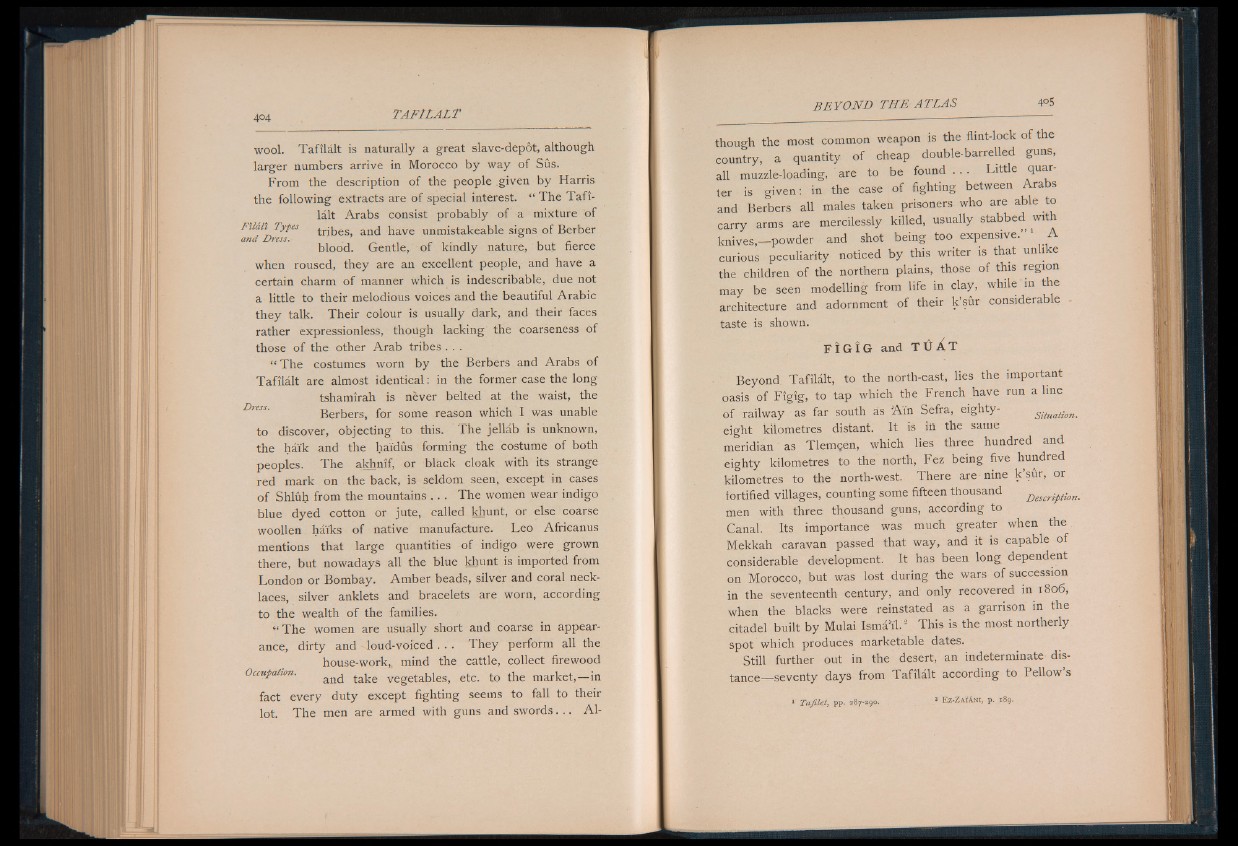
wool. Tafilalt is naturally a great slave-depot, although
larger numbers arrive in Morocco by way of Sus.
From the description of the people .given by Harris
the following extracts are of special interest. “ The Tafilalt
Arabs consist probably of a mixture of
Fildh Types ancj have unmistakeable signs of Berber
and Dress. i r
blood. Gentle, of kindly nature, but fierce
when roused, they are an excellent people, and have a
certain charm of manner which is indescribable, due not
a little to their melodious voices and the beautiful Arabic
they talk. Their colour is usually dark, and their faces
rather expressionless, though lacking the coarseness of
those of the other Arab tribes . . .
“ The costumes worn by the Berbers and Arabs of
Tafilalt are almost identical: in the former case the long
tshamirah is never belted at the waist, the
Berbers, for some reason which I was unable
to discover, objecting to this. The jellab is unknown,
the hai'k and the hai'dus forming the costume of both
peoples. The akhnif, or black cloak with its strange
red mark on the back, is seldom seen, except in cases
of Shluh from the mountains . . . The women wear indigo
blue dyed cotton or jute, called khunt, or else coarse
woollen haiks of native manufacture. Leo Africanus
mentions that large quantities of indigo were grown
there, but nowadays all the blue khunt is imported from
London or Bombay. Amber beads, silver and coral necklaces,
silver anklets and bracelets are worn, according
to the wealth of the families.
“ The women are usually short and coarse in appearance,
dirty and loud-voiced . . . They perform all the
house-work* mind the cattle, collect firewood
Occupation. ancj take vegetables, etc. to the market,— in
fact every duty except fighting seems to fall to their
lot. The men are armed with guns and swords. . . Although
the most common weapon is the flint-lock of the
country, a quantity of cheap double-barrelled guns,
all muzzle-loading, are to be fo u n d .. . Little quarter
is given: in the case of fighting between Arabs
and Berbers all males taken prisoners who are able to
carry arms are mercilessly killed, usually stabbed with
knives,— powder and shot being too expensive.” 1 A
curious peculiarity noticed by this writer is that unlike
the children of the northern plains, those of this region
may be seen modelling from life in clay, while in the
architecture and adornment of their k’sur considerable
taste is shown.
F I G I G and T U A T
Beyond Tafilalt, to the north-east, lies the important
oasis of Figig, to tap which the French have run a line
of railway as far south as Ain Sefra, eighty- situation.
eight kilometres distant. It is in the same
meridian as Tlemgen, which lies three hundred and
eighty kilometres to the north, Fez being five hundred
kilometres to the north-west. There are nine k sur, or
fortified villages, counting some fifteen thousand Descrif tion.
men with, three thousand guns, according to
Canal. Its importance was much greater when the
Mekkah caravan passed that way, and it is capable of
considerable development. It has been long dependent
on Morocco, but was lost during the wars of succession
in the seventeenth century, and only recovered in 1806,
when the blacks were reinstated as a garrison in the
citadel built by Mulai Isma'il.2 This is the most northerly
spot which produces ma.rketa.ble dates.
Still further out in the desert, an indeterminate distance—
seventy days from Tafilalt according to Pellow s